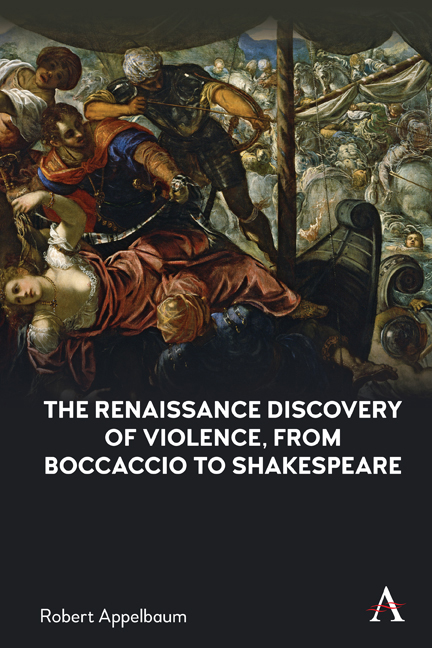Book contents
- Frontmatter
- Dedication
- Contents
- A Note on the Texts
- Acknowledgments
- Preface
- Chapter One Overture: The Show of Violence
- Chapter Two The Moral Economy of Violence in the Renaissance Novella Collection: Straparola, Bandello and Marguerite de Navarre
- Chapter Three Pacifism, Erasmus and More
- Chapter Four Violence as Labor: The Heroic Narrative
- Chapter Five “Tragedy Shows Us What We Must Flee From”
- Afterword
- Select Bibliography
- Index
Chapter One - Overture: The Show of Violence
Published online by Cambridge University Press: 16 December 2021
- Frontmatter
- Dedication
- Contents
- A Note on the Texts
- Acknowledgments
- Preface
- Chapter One Overture: The Show of Violence
- Chapter Two The Moral Economy of Violence in the Renaissance Novella Collection: Straparola, Bandello and Marguerite de Navarre
- Chapter Three Pacifism, Erasmus and More
- Chapter Four Violence as Labor: The Heroic Narrative
- Chapter Five “Tragedy Shows Us What We Must Flee From”
- Afterword
- Select Bibliography
- Index
Summary
1. Violence on Display
HORATIO
stay, and speak!—Stop it, Marcellus.
MARCELLUS
Shall I strike at it with my partisan?
HORATIO
Do, if it will not stand.
BERNARDO
’Tis here!
HORATIO
’Tis here!
MARCELLUS
’Tis gone! Exit Ghost
We do it wrong, being so majestical,
o offer it the show of violence;
For it is, as the air, invulnerable,
And our vain blows malicious mockery.
—Hamlet (1.1.120–27)A “show.” Of “violence.” A “show” first of all because violence has an outward appearance and form; it has been enacted, the soldiers playing their parts, striking the ghost with their “partisans” (spears), performing violence. But second, a “show,” a mere show, because this act of violence has no effect. The object, the ghost, it turns out, is “invulnerable.” The soldiers stab at mere air. Nevertheless, these ineffectual motions are “malicious,” expressing an intent to do harm, to seize the ghost against its will and even insult the ghost's rank, its majesty: for in the early modern period, moral agents, including law enforcers, were supposed to be respecters of persons. Violence itself could be measured against the status of the person it targeted, as well as the status of the person doing the targeting. Not just any violence but a violence of a certain kind, deployed in a certain kind of scene, using certain form of technology, a certain kind of pretext and certain types of characters, with certain varieties of motives and values, are all in question here, and both the characters themselves and we spectators are thrown into its midst, challenged to make sense of it.
Violence and its showing in a dual sense, then, is what we are faced with: first because violence can come with a show, a kind of performance; and second because the show of violence, once observed, is itself symbolically and morally visible, legible, decipherable and for that reason disputable too. The violence is viewed; an aggressive doing of right or wrong by way of force is caused to be observed, the character of the people involved is caused to be observed and we spectators are encouraged to respond to violence hermeneutically—that is, to interpret what is in front of us, with all the knowledge, tools of analysis, moral sentiments and emotional resources at our command.
- Type
- Chapter
- Information
- Publisher: Anthem PressPrint publication year: 2021

